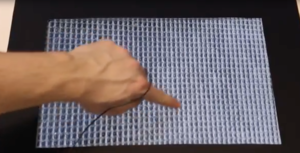Reproduction of textures based on electrovibration
2017
Miscellaneous
hi
This demonstration presents an approach to represent textures based on electovibration. We collect acceleration data which occurs while sliding a tool tip over a real texture surface. The prerecorded data was collected by a ADXL335 accelerometer, which is mounted on a FALCON device moving on the x-axis with a regulated velocity. In order to replicate the same acceleration with electrovibration, we found two problems. The frequency of one sine wave shifts to the double frequency. This effect originates from the electrostatic force between the finger pad and the tactile display as proposed by Kactmarek et Al. [1]. Taking the square root of the input signal corrects the effect. This was also earlier proposed by [1, 2, 3] However, if not only one but multiple sine waves are displayed interference occur and acceleration signals from real textures may not feel perceptually realistic. We propose to display only the dominant frequencies from a real texture signal. Peak frequencies are determined within the respect of the JND of 11 percent found by earlier literature. A new sine wave signal with the dominant frequencies is created. In the demo, we will let the attendees feel the differences between prerecorded and artificially created textures.
| Author(s): | Fiedler, T. and Vardar, Y. and Strese, M. and Steinbach, E. and Basdogan, C. |
| Year: | 2017 |
| Department(s): | Haptic Intelligence |
| Bibtex Type: | Miscellaneous (misc) |
| How Published: | Demo in IEEE World Haptics |
|
BibTex @misc{demo_texture,
title = {Reproduction of textures based on electrovibration},
author = {Fiedler, T. and Vardar, Y. and Strese, M. and Steinbach, E. and Basdogan, C.},
howpublished = {Demo in IEEE World Haptics},
year = {2017},
doi = {}
}
|
|


